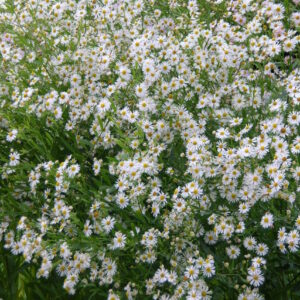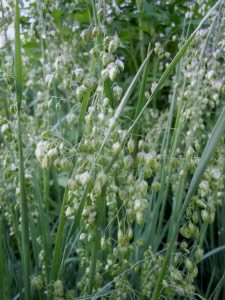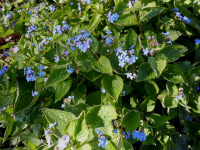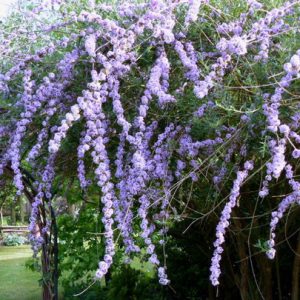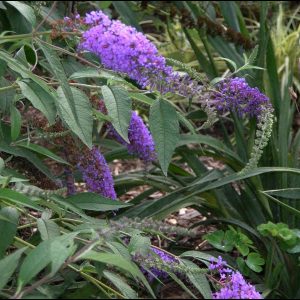Our Plants
Showing 97–104 of 616 results
-
Bletilla striata syn. B. hyacinthina Chinese ground orchid Z 5-9
Racemes of pinkish-purple flowers on scapes above dark green, upright, lance-shaped leaves, April-May
OUT OF STOCK
Racemes of pinkish-purple flowers on scapes above dark green, upright, lance-shaped leaves, April-May
Size: 12-18” x 12”
Care: Part shade in moist, well-drained soil.
Native: China, Japan
Wildlife Value: Attracts bees, butterflies and hummingbirds. Deer & Rabbit resistant.
Awards: Royal Horticultural Society Award of Garden MeritProtect with thick winter mulch, may not reliably survive Zone 5 winters.
Spreads slowly by rhizomes and seeds in optimal conditions.
‘Bletilla’ honors Louis Blet, a Spanish apothecary in Algeciras who also had a botanic garden at the end of the 18th century. Collected before 1784 by Thunberg. -
Boltonia asteroides False starwort, Bolton’s aster Z 4-9
“Bloom profusely” majestic, white daisies cover imposing, cheerful plant, August – September
“Bloom profusely” majestic, white daisies cover imposing, cheerful plant, August – September
Size: 5-6' x 3'
Care: full sun to part shade in moist well-drained soil.
Native: Maine to Florida, west to Texas and north to North Dakota and all areas in between, Wisconsin
Wildlife Value: provides pollen to over 40 bee species, moths, butterflies and wasps.Named in honor of 18th century English botanist, James Bolton. Asteroides means resembling as aster. Species introduced in 1758. Recommended for fall blooms in Wisconsin State Horticultural Society Annual Report, 1911.
-
Bouteloua curtipendula Sideoats grama Z 4-8
Narrow, blue-green leaves tinged purple or red in fall when golden oat-like seeds hang down one side of each leaf, eye-catching.
Narrow, blue-green leaves tinged purple or red in fall when golden oat-like seeds hang down one side of each leaf, eye-catching.
Size: 2-3' x 1'
Care: Sun in well-drained to moist well-drained soil, drought tolerant
Native: most of US, incl. Wisconsin
Wildlife Value: nesting material for butterflies and bees; larval host for some Skipper butterflies,
Awards: state grass of TexasKiowa natives who had killed an enemy in battle with a lance wore this. Collected and described by French planthunter André Michaux (1786-1802) who scoured Eastern North America west to the Mississippi over 11 years.
-
Bouteloua gracilis Blue grama Z 4-9
One sided, horizontal, purple tinged spikelets looking like a row of eyelashes, July-October
One sided, horizontal, purple tinged spikelets looking like a row of eyelashes, July-October.
Size: 2' x 12"
Care: sun in dry to moist well-drained soil
Native: all US except SE & NW, Wisconsin native
Wildlife Value: Host for caterpillars of Green skipper butterfly. Deer resistant
Awards: Great Plants for Great Plains Grass of the Year 2008For the Navajo this was a “life medicine” and an antidote to an overdose of “life medicine.” Also used to cure sore throats and cuts – chew on the root and blow on the cut. Navajo girls carried it in the Squaw Dance. Hopi made baskets from this grass. Zuni made brooms & hairbrushes from it. Several tribes ate this & made bedding for their animals from this. Lakota children played a game using this grass: Most of the stems have two flowers on them. Children competed to see who could find the stems with three flowers, like finding a four-leaf clover. First collected for horticulture by Humboldt & Bonpland who scoured Latin America from 1799-1804.
-
Briza media Quaking grass, Pearl grass, Didder, Totter, Dillies Z 4-8
Elegant inflorescences with dangling oat-like spikelets
Elegant inflorescences with dangling oat-like spikelets in May. Use for cut arrangements, fresh or dried
Size: 30” x 10”
Care: full sun to part shade in any soil. Deer resistant.
Native: Eurasia.In cultivation since at least mid 1700’s.
-
Brunnera macrophyllum Siberian bugloss Z 3-7
Panicles of robin's egg blue forget-me-not- type flowers in May and June, contrast with bold, round foliage. One of the best spring flowers.
Panicles of robin’s egg blue forget-me-not- type flowers in May and June, contrast with bold, round foliage. One of the best spring flowers.
Size: 12" x 12"
Care: part shade to shade in moist to moist well-drained soil
Native: Caucasus & Siberia
Awards: Royal Horticultural Society Award of Garden MeritNamed for Swiss botanist Samuel Brunner (1790-1844). Collected by Russian botanist Johann Friedrich Adam (1780-1838) in Siberia c. 1806.
-
Buddleja alternifolia ‘Argentea’ Silver fountain butterfly bush Z 5-9
Graceful, arching, weeping silvery foliage with cascading lavender flowers
Graceful, arching silvery foliage and, in early summer, lavender, fragrant flowers cascade all along the stems. A cloud of purple.
Size: 8-10” x 8-10” fast growing
Care: sun to part shade in moist well-drained to well-drained soil. Prune just after blooms finish if you wish.
Native: China & Japan
Wildlife Value: attracts butterflies
Awards: 1998 Plant Select ® awardBuddleja named to honor botanist Reverend Adam Buddle, Vicar of Farmbridge in Essex, (1662-1715) Alternifolia means the leaves alternate on the stem. The 1st Buddleja alternifolia was found by plant hunter and horticulture author Reginald Farrer (1880-1920) in western China in 1914. The cultivar’s name ‘Argentea’ means silver due to the tiny hairs on the foliage giving the plant a silvery appearance. ‘Argentea’ selected at Hillier Nursery in England in 1939.
-
Buddleja davidii Butterfly bush, Summer lilac, do ye zui cao in China Z 5-9
Fragrant, large, lilac to purple arching spikes from mid-summer through fall
Fragrant, large, lilac to purple arching spikes from mid-summer through fall
Can not ship to: Delaware, Maryland, North Carolina, Oregon, Pennsylvania, Tennessee and Washington
Size: 6' x 4'
Care: Sun in well-drained soil.
Native: Sichuan & Hubei provinces, China
Wildlife Value: flowers very fragrant, attracts many butterflies, excellent cut flower
Awards: Royal Horticultural Society Award of Garden Merit.Buddleja named to honor Reverend Adam Buddle, Vicar of Farmbridge in Essex and botanist. (1662-1715) Davidii honors Fr. Armand David a French missionary who noticed it. Introduced to gardens by another French missionary Jean Soulie (1858-1905). Soulie made dangerous expeditions to the Tibetan border of China and ultimately lost his life when he was tortured and shot in 1905. This species 1st sent to the West (Kew Gardens) by Dr. Ernest Henry who found it near Ichang in 1887. Irishman Dr. Henry worked as a customs officer in Shanghai and an assistant physician in Ichang.


